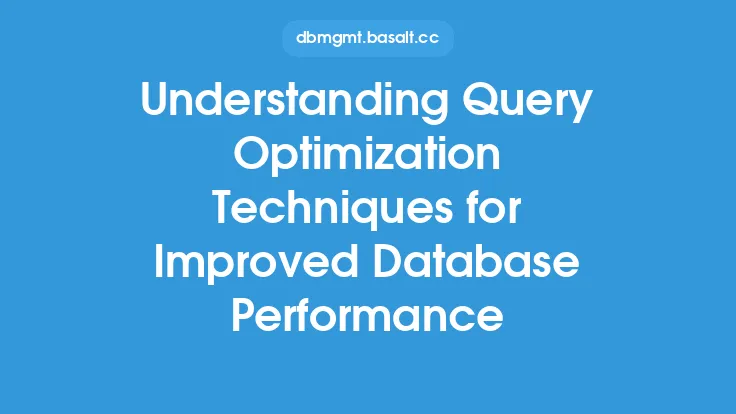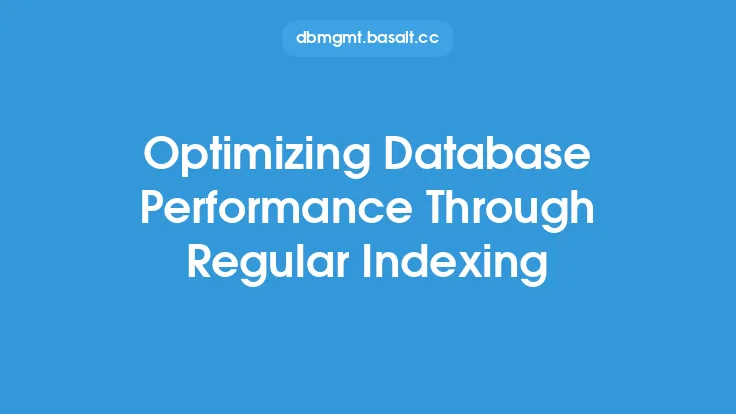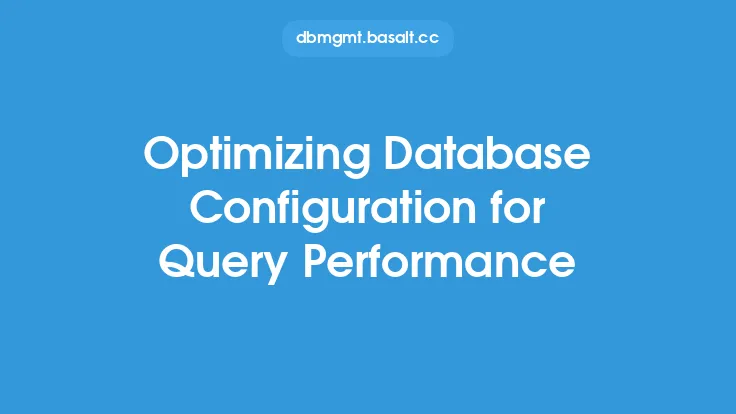When it comes to optimizing database performance, indexing is a crucial aspect that can significantly impact the efficiency of query execution. Indexing strategies are designed to reduce the time it takes for the database to locate and retrieve specific data, thereby improving overall system performance. In this article, we will delve into the world of indexing strategies, exploring the different types of indexes, their advantages and disadvantages, and how to choose the most effective indexing strategy for your database.
Introduction to Indexing Strategies
Indexing strategies are techniques used to create and manage indexes in a database. An index is a data structure that improves the speed of data retrieval by providing a quick way to locate specific data. Indexes can be created on one or more columns of a table, and they can be used to speed up various types of queries, including SELECT, INSERT, UPDATE, and DELETE statements. There are several types of indexing strategies, including B-tree indexes, hash indexes, and full-text indexes, each with its own strengths and weaknesses.
Types of Indexes
There are several types of indexes that can be used in a database, including:
- B-tree indexes: These are the most common type of index and are used to index data that is stored in a B-tree data structure. B-tree indexes are efficient for range queries and are often used in databases that require frequent inserts, updates, and deletes.
- Hash indexes: These are used to index data that is stored in a hash table data structure. Hash indexes are efficient for equality queries and are often used in databases that require frequent lookups.
- Full-text indexes: These are used to index large amounts of unstructured data, such as text documents. Full-text indexes are efficient for searching and retrieving data that contains specific keywords or phrases.
- Composite indexes: These are used to index multiple columns of a table. Composite indexes are efficient for queries that filter on multiple columns.
- Unique indexes: These are used to ensure that each value in a column is unique. Unique indexes are efficient for queries that require unique values.
Advantages and Disadvantages of Indexing Strategies
Indexing strategies have several advantages, including:
- Improved query performance: Indexes can significantly improve the speed of query execution, especially for complex queries that require filtering, sorting, and joining.
- Reduced disk I/O: Indexes can reduce the amount of disk I/O required to retrieve data, which can improve system performance and reduce wear and tear on disk drives.
- Improved data integrity: Indexes can be used to enforce data integrity constraints, such as uniqueness and referential integrity.
However, indexing strategies also have some disadvantages, including:
- Increased storage requirements: Indexes require additional storage space, which can increase the overall size of the database.
- Increased maintenance requirements: Indexes require periodic maintenance, such as rebuilding and reorganizing, to ensure that they remain efficient and effective.
- Potential for index fragmentation: Indexes can become fragmented over time, which can reduce their effectiveness and increase maintenance requirements.
Choosing the Right Indexing Strategy
Choosing the right indexing strategy depends on several factors, including the type of data, the frequency of queries, and the performance requirements of the system. Here are some tips for choosing the right indexing strategy:
- Identify the most frequently accessed columns: Indexes should be created on columns that are frequently accessed by queries.
- Consider the type of queries: Different types of queries require different types of indexes. For example, range queries require B-tree indexes, while equality queries require hash indexes.
- Consider the data distribution: Indexes should be created on columns that have a unique or near-unique distribution of values.
- Monitor and adjust: Indexing strategies should be monitored and adjusted over time to ensure that they remain effective and efficient.
Implementing Indexing Strategies
Implementing indexing strategies requires careful planning and execution. Here are some steps to follow:
- Analyze the database schema: Identify the tables and columns that require indexing.
- Choose the right indexing strategy: Based on the analysis, choose the most effective indexing strategy for each table and column.
- Create the indexes: Use the database management system's indexing tools to create the indexes.
- Monitor and maintain: Monitor the indexes and perform periodic maintenance to ensure that they remain efficient and effective.
Best Practices for Indexing Strategies
Here are some best practices for indexing strategies:
- Keep it simple: Avoid creating complex indexes that are difficult to maintain and optimize.
- Use indexing tools: Use the database management system's indexing tools to create and manage indexes.
- Monitor and adjust: Monitor the indexes and adjust them as needed to ensure that they remain effective and efficient.
- Consider data partitioning: Consider partitioning large tables to improve query performance and reduce index maintenance requirements.
- Consider parallel processing: Consider using parallel processing techniques to improve query performance and reduce index maintenance requirements.
Common Indexing Strategy Mistakes
Here are some common indexing strategy mistakes to avoid:
- Over-indexing: Creating too many indexes can increase storage requirements and reduce system performance.
- Under-indexing: Failing to create enough indexes can reduce query performance and increase disk I/O.
- Incorrect indexing: Creating indexes on the wrong columns or using the wrong type of index can reduce query performance and increase maintenance requirements.
- Failing to maintain: Failing to perform periodic maintenance on indexes can reduce their effectiveness and increase maintenance requirements.
Conclusion
Indexing strategies are a crucial aspect of database performance optimization. By understanding the different types of indexes, their advantages and disadvantages, and how to choose the most effective indexing strategy, database administrators can improve query performance, reduce disk I/O, and improve data integrity. By following best practices and avoiding common mistakes, database administrators can ensure that their indexing strategies remain effective and efficient over time.





